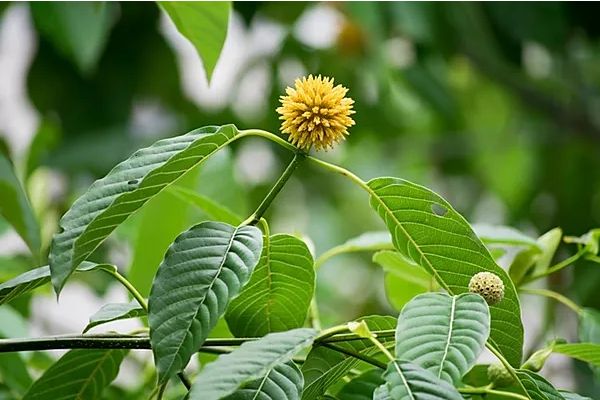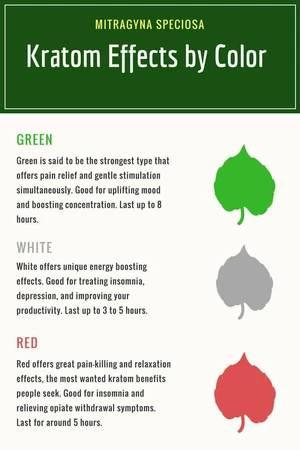Kratom (lat: mitragyna speciosa, kratom, krathom, ithang, kakuam, thom, ketum, biak): - a rare tree from the madder family (a relative of coffee), common in Tailandia, Malasia, Myanmar, Papua Nueva Guinea.

Classical consumers of kratom are peasants, laborers and farmers who use kratom to somehow brighten up disgusting reality and easier to cope with hard physical work and exhausting work in the field. In Bangkok, the drivers of the amazing tuk-tuk vehicle use Kratom as a means of letting them always feel alert and full of vitality. The average age of a kratom consumer is usually greater than the age of a consumer of other substances. Strongly addicted people usually chew Kratom 3-10 times a day.
There are 2 types of kratom, according to the color of leaf veins (red or green / white). A study conducted among Thais using kratom showed that most prefer a mixture of both varieties; after the mixture, a variety with red veins is usually used, then with green ones. Australian researchers report that red and green veins appear at different times on different plants cloned from the same mother.
In a biochemical sense, Kratom is similar to plants: corynanthe, cinchona and uncaria. Kratom leaves contain more than 25 alkaloids. The alkaloids content depends on the terrain and the time of year. In each place of growth, there is a quantitative change in the content of alkaloids depending on the time of year. The main alkaloids: mitraginine, 7-hydroxymitraginine (7-OHM), epicatechin (a powerful antioxidant found in dark chocolate and closely related to EGCG, which gives green tea its beneficial properties), raubasine (the most famous of rauwolfia serpentina), corinantheidine, paranantheidin, specogenin, mitraversin, ricophyllin, specociliatin, stipulatin.
Mitraginin is the dominant plant alkaloid. It was first isolated in 1907 by D. Hooper. This process was repeated in 1921 by I. Field, who gave the name alkaloid. For the first time, its structure was completely determined in 1964 by D. Zakarias, R. Rosenstein and I. Jeffrey. Structurally, this alkaloid is similar to the alkaloids yohimbe and voacangin. Its affinity with other tryptamine-based psychedelic substances, such as LSD or psilocybin, is less pronounced. Chemically, mitraginin is called 9-methoxy-corinantheidine. Its molecular formula is C23H30N2O4 and its molecular weight is 398.5. Basic mitraginin looks like a white non-crystalline powder, melting at 102-106 degrees, and boiling at 230-240 degrees. It is soluble in alcohol, chloroform and acetic acid. The hydrochloride salt dissolves at 243 degrees.

Mitraginin is administered through the delta and mu opioid receptors. At low dosages, mitraginin shows a connection with alpha-adrenergic receptors, in the manner of yohimbine, as well as a connection with delta-opioid receptors. With increasing doses, communication with delta receptors intensifies; the crossover of mu receptors follows. The opioid effects of mitraginin are comparable to those of codeine in strength. Mitraginin suppresses cough and anesthetizes. Unlike codeine, mitraginin suppresses coughing without causing vomiting and shortness of breath.
Kratom is legal everywhere except Thailand, Malaysia, Burma and Australia. The Thai government passed the Kratom Act 2486, which entered into force on August 3, 1943. In accordance with this law, tree planting was declared illegal, and existing trees had to be cut down. This law was found to be ineffective, since this tree is part of the country's ecosystem. In our time, Thai law classifies Kratom in the same group as heroin and cocaine and applies the same penalties to it. For the storage of one ounce of the extract faces the death penalty. This law, as well as prohibitive laws around the world, only contributed to the soaring prices of Kratom on the black market. A related species, mitragyna javaica, is often used as a means to circumvent the law, but it is not so effective. The dominant alkaloid in plants of this species is mitrayavin, which has not yet undergone pharmacological tests.
Story:
The traditional use in Thailand goes back into time, and its beginning cannot be determined. The first reference to Kratom in Western literature was by Lowe, who wrote in 1836 that the Malaysians used the plant as a substitute for opium if the latter was unavailable or too expensive.
In some parts of Thailand, it is believed that parents will give their daughters to those who use kratom, rather than those who use marijuana.
There is an opinion that those who use kratom are hardworking, and those who use marijuana are lazy. This opinion is supported by many people who report that they began to use the plant because of the desire to work more efficiently; they argue that kratom creates a lasting desire to work.
Although some people (primarily in Thailand) have become dependent on kratom, the plant does not form addiction if used correctly: addiction is possible only if kratom is used in doses high enough for crossover mu receptors.
In 1895, E.M. Holmes identified Kratom as mitragyna speciosa, and reiterated its use as a substitute for opium. In 1907, L. Vray described application methods such as smoking, chewing, and tea. Hoping that the active chemical component could be discovered and investigated for medical use, Vray sent the leaves of kratom and a related plant, mitragyna parvifolia, to the University of Edinburgh; it was from these samples that Field isolated mitraginine (and mitraversin from m. parvifolia).
In 1930 I.Kh. Berkill wrote that Kratom was also used as a poultice for wounds and as a cure for fever.
In medicine:
Kratom has a high potential for use in medicine as a safer and cheaper alternative to methadone: it has the ability to alleviate the withdrawal syndrome from morphine-like opiates, since it itself contains opioid agonists. There is more recent evidence indicating that mitraginin has been used in New Zealand to treat methadone addiction. According to this information, the patient smoked kratom every time he felt withdrawal symptoms; the treatment period was 6 weeks. The patient reported vivid hypnagogic dreams.
In 1999, Pennapa Sapperon, director of the National Institute of Thai Traditional Medicine in Bangkok, stated that Kratom can be used both for treating opiate addiction and for treating patients suffering from depression, but emphasized the need for further research. Chemists at Chulalongkorn University have identified mitraginin, which researchers can get to study.
In addition to being used as a psychoactive plant, Kratom is used by Malay healers to deworm, improve blood circulation, increase tone, suppress cough and diabetes symptoms. It is also used for such ailments as an enlarged spleen; It has an analgesic effect and promotes wound healing: fresh leaves of M. Speciosa are crushed and applied to wounds. It is used as a remedy for diarrhea, fever.
Application and action:
The uniqueness of this plant is that a small dose usually works as a stimulant (but not always), and large doses as a relaxant. And this is understandable, because active alkaloids (primarily mitraginin) have a stimulating and sedative effect.
Effects of a stimulant (1-5 g):
A lot of physical energy, and sometimes sexual. Increased ability to do monotonous physical work. A person becomes more talkative, sociable, and more friendly. At the level of stimulation, the mind is more attentive.
Soothing, sedative, analgesic effect (5-10 gr):
The first effects begin 10 minutes after taking tea; the effect is manifested in pleasant waves running through the body, especially along the limbs. After 30 - 45 minutes, the effect is significantly enhanced. Euphoria comes and the body feels great. Disappear, or lose value, pain. Some itching or sweating has been experienced. Possible nausea. The effect lasts approximately 2 hours at full strength; then - nice post effects for another 2 hours. In addition, kratom may cause inability to focus vision.
Kratom excites opioid deltas and mu receptors, but also gives effects uncharacteristic for opiates: it changes vision, brightens colors, causes unobtrusive hallucinations, euphoria, a sense of unity with nature. The plant causes the body and mind to work and learn; gives a feeling of complete well-being.
Kratom cannot be combined with stimulants (yohimbine, cocaine, amphetamine, caffeine in high doses) because of the danger of excessive stimulation and increased blood pressure. It cannot be combined with depressants (large amounts of alcohol, benzodiazepines, opiates) because of the potential for breathing problems.
A warning:
Health problems are unlikely if you do not use kratom every day. In Thailand, there are people who use it every day and it has become a habit. They noticed weight loss, dark pigmentation of the face (especially on the cheeks, which makes a person look like hepatitis patients) and physical problems if they quickly stop taking it. Physical problems are muscle pain (brittleness), irritability, they can scream, snot from the nose flow, diarrhea, and cramps. 30% of people who constantly take Kratom experience a decrease in sexual desire, they need to take a mixture of Kratom and alcohol in order to experience sexual arousal.
Doses are selected individually!
If you are taking medication, then Kratom should be taken 4 hours after taking the medication.
Kratom should not be taken by people with high blood pressure!
-------------------------
What does Kratom need to maximize its benefits?
The first is the proper storage of Kratom.
If you get fresh kratom (tea or powder), then its quality depends on storage conditions.
Store Kratom in a dark, dry and cool place. In the light, he, like any other herbal preparation, quickly loses its qualities.
The best option is to store kratom powder in an airtight container in the refrigerator (many do not know that this is the best way to store bulk products after opening airtight packaging - for example, ground coffee). But if you have a small amount of Kratoma, you are not going to “stretch the pleasure” for many months - a closed cabinet in the apartment, in a dry place, is quite suitable for keeping Kratom. And you need to store the powder in places inaccessible to children - they are unlikely to eat it, but can pour it out.
How to enhance the effect of Kratom and its consumption?
The necessary substances from the leaves are released gradually, so Kratom needs to be insisted longer. Minimum 20 minutes. And mix well.
Acidic medium for it is a catalyst - you need to add lemon to tea (not a slice, but half a lemon), you can lime juice, grapefruit or orange ... This will not only enrich the taste of Kratom, but will also contribute to its better absorption. and hence its effect on the human body.
Sweet contributes to better absorption - you can add a spoon, two honey or sugar.
Spice. You can have a little turmeric, cinnamon, other spices to taste, this will only enhance the effect of Kratom. Some people drink kratom with rooibos, frosted tea ... But caffeine and thiamine are not friends with kratom, so it’s better not to mix kratom with classic tea and coffee, and it’s better to divide their consumption by time.
It is useful to drink a glass of juice (freshly squeezed) grapefruit 20-30 minutes before drinking Kratom - this will contribute to better absorption of mitragin alkaloid, the main active ingredient in Kratom.
Do not eat half an hour before and after using kratom, so as not to dilute the absorption of the drug.
A very good way to enhance the effect of Kratom is to brew it in a thermos. Hot water (about 70-80 ° C), but not boiling water, pour into a thermos with Kratom powder. Add the juice of half a lemon (lime grapefruit), honey, sugar or another sweetener to taste and infuse for about one and a half to two hours.
To achieve the best effect, it is recommended to take Kratom tea in the morning on an empty stomach.
Features of the use and dosage of Kratom for tone:
To stimulate physical and mental activity, experts recommend taking from 1 to 5 g of Kratom (from half a teaspoon to a teaspoon with a slide) at the same time. And so that the stimulating effect does not disappear over time, Kratom should be consumed no more than once a day and no more than two to three times a week.
Kratom for analgesic effect:
One of the most popular properties of Kratom is the elimination of pain in chronic diseases and during or after hard physical work and sports training. Kratom, in some cases, is an excellent natural substitute for artificial (synthetic) analgesics, which is constantly detected in practice. In this case, you need to start taking Kratom in a dose of 6 g, and if necessary, gradually increase to 10-15 g. It happens that in some cases you may need to take large doses.
For anesthetic effect, red Kratom varieties are usually purchased.
Sedative (sedative) effect of Kratom:
Using 10 or more grams of Kratom at a time, you can expect a pronounced relaxing effect. Great for relaxing - a good evening at home, listening to music, relaxing after a hard day.
Kratom dosage for withdrawal withdrawal symptoms (post-drug syndrome):
Kratom has proven to be a natural alternative to chemicals that help smooth out drug withdrawal syndrome (especially opiates) and even alcohol dependence. Kratom does not have such a strong effect as methodon, but for a person who decided to give up drugs, he is a good substitute for synthetic drugs.
In this case, a single dose can be from 15 to 50 g of crushed kratom leaves, two to four times a day for the first three days. On the fourth day and further it is necessary to reduce the dose, watching your well-being ...
Kratom is legal (distributed freely) in most countries of the world and in most US states (prohibited in only five states). Kratom is permitted in most EU countries, but its circulation is controlled in Denmark, Finland, Lithuania, Poland, Romania, Sweden. In Ukraine, Kratom is completely legal. In Russia, the main component of kratom - the alkaloid mitraginin is prohibited. In the homeland of Kratom in Southeast Asia, it is banned for sale and use in Australia, Bhutan, Burma, Thailand, Malaysia, but at the same time it is legal to grow.
Not so long ago, Kratom was banned in Ireland - he ended up in the same drug class as heroin. According to a survey among officials who voted to ban Kratom, many of them did not even know what Kratom and its properties are ...
There is a risk that anti-drug rhetoric, caused by ignorance and fear on the one hand, and the promotion (lobbying) of the interests of pharmacological companies on the other, will harm Kratom's positive reputation and lead to the fact that many countries will make its status illegal.

Until the promotion is canceled, a discount on any tea 5 euros!
Price:
Packiung 25 gr - 15 euro
Packiung 50 gr - 25 euro
Packiung 100 gr - 40 euro
When ordering, indicate the grade: Tonic or Relaxing
When ordering 100 euros or more - free delivery in the EU



